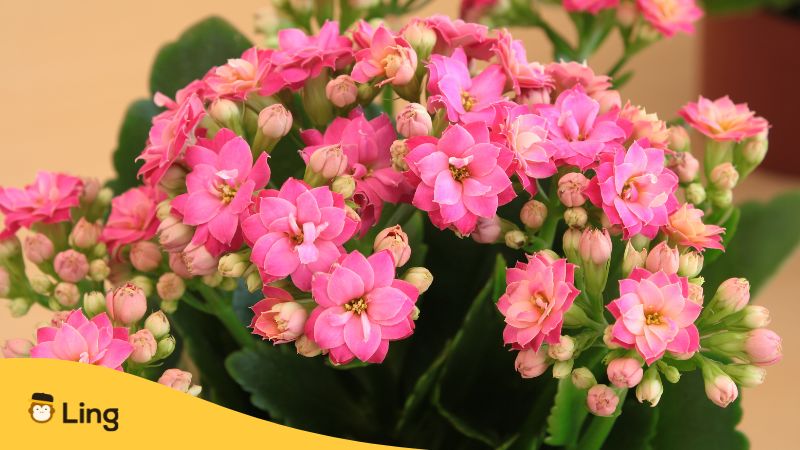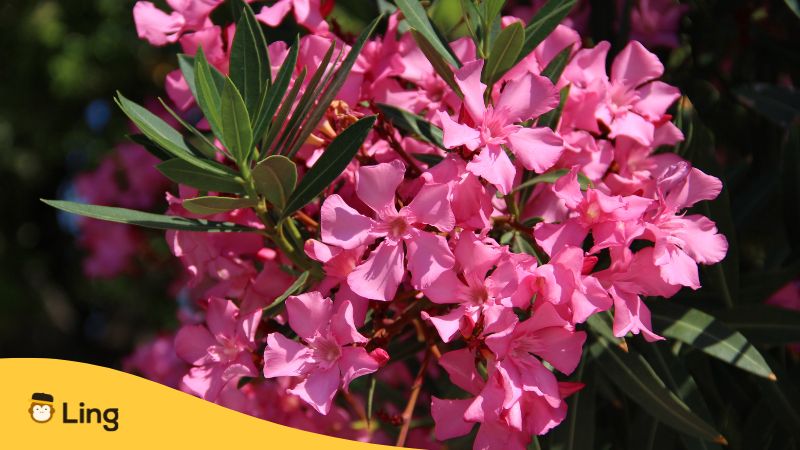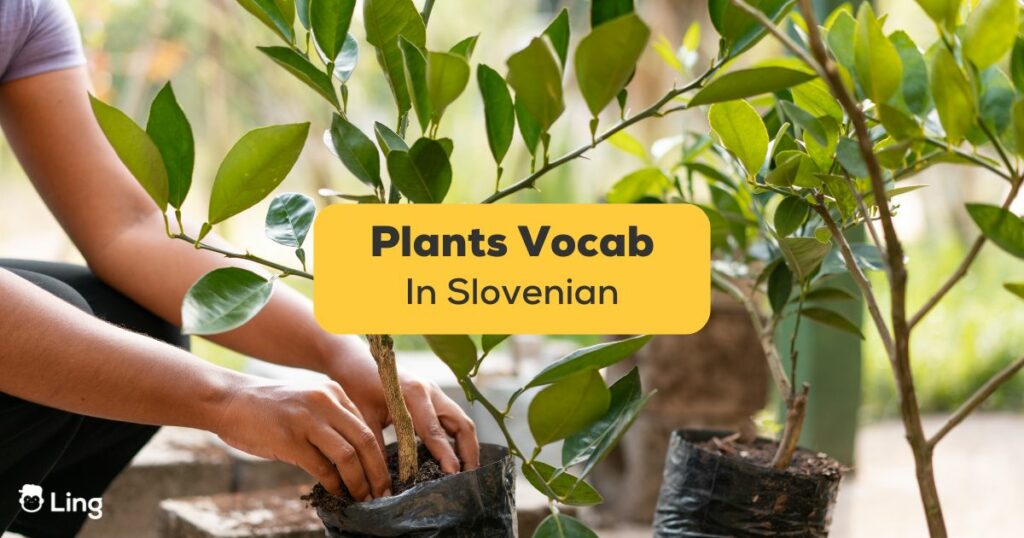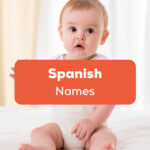If you’re a vegan or a plant mom (or dad!), it’s natural that you may want to have a conversation about plants in Slovenian. But to do that, you should learn some Slovenian vocabulary. The first word you need to learn is rastlina, which means plant in Slovenian.
If you can’t wait to learn other plant-related words, let’s not beat around the bush and get right into the blog post!
Most Common Plants In Slovenian
Let’s start by learning the most commonly grown plants in Slovenia. Some of them are Golden Pothos, Florist Kalanchoe, Zanzibar Gem, Pepper, Swiss cheese plant, and so on! You can come across these common plants in parks or public gardens in Slovenia.
1. Golden Pothos – Zlati Pothos
Botanical name: Epipremnum aureum.
The Zlati Pothos (Golden Pothos) is a popular houseplant commonly seen in Slovenian homes. It has many nicknames, like “devil’s ivy,” because it’s so durable and doesn’t die easily. It can even grow in places with limited light. But keep in mind that Golden Pothos has a poisonous sap, so you should keep it away from pets and kids.

2. Florist Kalanchoe – Cvetličarna Kalanchoe
Botanical name: Kalanchoe blossfeldiana.
Cvetličarna Kalanchoe (Florist Kalanchoe) originates from Madagascar but has been a popular houseplant in Slovenia since the 1930s. Unlike most other succulents, which are grown for their interesting leaves, the Florist Kalanchoe is grown for the colorful flowerheads it produces during autumn and winter. Since it’s a winter flower, it’s also known as the Christmas kalanchoe. But be careful, as it’s toxic to pets.
3. Zanzibar Gem – Zanzibarski Dragulj
Botanical name: Zamioculcas zamiifolia.
The Zanzibarski Dragulj (Zanzibar Gem) is a green plant native to East Africa. It’s also known as the Emerald Palm because it has a bright and glossy green color. Today, the Zanzibar Gem is grown as a houseplant everywhere in the world, including central Europe and the Balkan Peninsula, since it’s very easy to grow and take care of. But make sure your pets don’t eat this plant, as it’s mildly toxic as well.
4. Pepper – Poper
Botanical name: Capsicum annuum.
The pepper is a plant that’s commonly used for cooking. For example, cayenne powder is a popular seasoning made from the pepper plant. Most of them are moderately spicy, but since there are a lot of species, the spice level can vary significantly.
5. Swiss Cheese Plant – Monstera
Botanical name: Monstera deliciosa.
The Monstera (also known as the Swiss Cheese Plant) has large, bright, and glossy leaves, which makes it a popular houseplant. It’s native to tropical regions in Central America. But what’s up with the nickname “Swiss Cheese” Plant? It actually refers to the small holes in the plant’s leaves because they really look like the holes in Swiss Cheese!
6. Jade Plant – Žad
Botanical name: Crassula ovata.
Žad (Jade plant) is one of the world’s most popular succulents, and I think it looks like a mini fairy tale tree. Though it’s native to southern countries of Africa, the Jade Plant is well adapted to the dry, warm air of today’s modern homes. It’s a long-living plant that can be passed from generation to generation. However, remember that it’s toxic to animals and even to humans at a mild level.
7. Aloe Vera – Aloja
Botanical name: Aloe vera.
Aloja (Aloe vera) is an evergreen succulent plant native to the Arabian Peninsula. Its thick leaves are filled with gooey flesh that stores water for survival in its native desert territories. Besides being a popular houseplant, Aloe Vera is also used in cosmetics, skin-care products, and folk medicine.

8. Oleander – Mandljevec
Botanical name: Nerium oleander.
Mandljevec (Nerium Oleander) is a shrub-like plant or small tree famous for its large pink five-lobed flowers and deep green lanceolate leaves. In contrast to its pretty appearance, Oleander is one of the most poisonous garden plants, so you should keep kids and pets away from it!
9. English Ivy – Angleški Bršljan
Botanical name: Hedera helix.
Angleški bršljan (English Ivy) is one of the most common climbers of Slovenian forests and gardens. It’s a perennial woody vine with evergreen, dark, shiny, lobed leaves. It uses aerial rootlets to attach to tree bark with exceptional strength, helping it creep more than 15 m up a tree.
10. Sweet Basil – Sladki Bazilik
Botanical name: Ocimum basilicum.
Sladki Bazilik (Sweet basil) is a sub-species of the mint plant native to Asia and Africa. It’s a popular houseplant because it’s so easy to take care of. It thrives in a short time as long as it receives regular sunlight and water. Also, you can use the edible basil leaves (fresh or dried) in pizza, salads, soups, teas, and many other foods and drinks.
Other Plants In Slovenian
Here’s some plant-related vocabulary, along with other popular plants, trees, and flowers with their Slovenian names:
| English | Slovenian |
|---|---|
| Tree | Drevo |
| Flower | Cvet |
| Leaf | List |
| Grass | Trava |
| Bush | Grm |
| Shrub | Grmček |
| Seedling | Sadika |
| Berries | Jagodičevje |
| Plant | Rastlina |
| Weed | Plevel |
| Root | Korenina |
| Trunk | Deblo |
| Branch | Vejica |
| Stem | Koren |
| Seed | Seme |
| Bouquet | Šopek |
| Rose | Vrtnica |
| Sunflower | Sončnica |
| Poppy | Mak |
| Willow | Vrba |
| Birch | Breza |
| Oak | Hrast |
| Spruce | Smreka |
| Pine | Bor |
| Tulip | Tulipan |
| Daisy | Marjetica |
| Dandelion | Regrat |
| Lily | Lilija |
| Orchid | Orhideja |
| Fern | Praprot |
| Ivy | Bršljan |
| Cactus | Kaktus |
| Bamboo | Bambus |
| Moss | Mah |
| Lavender | Sivka |
| Thyme | Timijan |
| Mint | Meta |
| Parsley | Peteršilj |
| Sage | Žajbelj |
| Chamomile | Kamilica |
| Thistle | Osat |
| Clover | Detelja |
| Honeysuckle | Zlati dež |
| Hydrangea | Hidrangeja |
| Wisteria | Glicinija |
| Daffodil | Narcis |
| Hyacinth | Hijacinta |
| Peony | Božični šopek |
| Dahlia | Dalija |
| Lilac | Bezeg |
Let’s Start Learning Slovenian Vocabulary!
All these lush greenery and vibrant plants mentioned above can be refreshing and uplifting for people who are into gardening. But whether you’re into gardening or not, you’ll still fall in love with the plants in Slovenia!
In today’s blog post, we’ve covered words for plants in Slovenian and learned the most common houseplants. If you are interested in learning about the Slovenian language and culture, you can learn more Slovenian words and phrases like the ones above by using the Ling app! It’s an easy-to-use language-learning app with 60+ languages to choose from, including East European languages like Slovenian. Give it a try!


































































